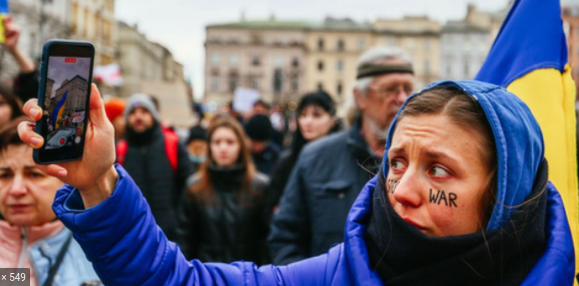How the Advancements of Technology are Helping Us Look Into the Russian and Ukrainian Crisis.

March 21, 2022
Today, social media has given us a front-row seat to the Russian invasion of Ukraine. As we scroll through TikTok and other big social media platforms we are continuously hit with sobering and violent videos and images of young men at war, citizen´s homes being destroyed by missiles, fathers with tear-filled eyes tightly embracing their children before going off to war, just in case, and people doing whatever they can to protect and defend their cities. As of recently, social media has helped return our focus to the human cost and individual human responses, from bravery to disparity, rather than the reasons for Russia’s invasion of Ukraine.
It is as though social media has created a window into the war’s destruction through the glass of our screens by showing us that a conflict with such seriousness comes from the people it truly devastates, not just from newscast reports and journalism. A Times article stated, ¨People in Ukraine and around the world are watching the crisis unfold not only through traditional news sources, but also on social media via raw, personal TikTok videos, Instagram stories, and tweets. It’s not exactly the “first social media war,” as some have branded it; social media has been used to document other armed conflicts, such as the Syrian war that began in 2011. But the way wars are covered on social media has drastically changed over time.¨ With so much coverage and the power of social media many have questioned misinformation and propaganda but it’s because of platforms and media support that we are able to share our sympathy for so much suffering and where Ukrainians are able to urge their followers to pray for Ukraine, donate to support the Ukrainian military and demand Russian users in particular to join anti-war efforts.
Many of Ukraine’s individuals are using their platforms as ¨media work¨ as some may call it as a way to educate their viewers and show them what it’s like to live in Ukraine during this time. Ukrainian social media influencers posted bleak images of themselves wrapped in blankets in underground bunkers and army tanks rolling down residential streets, juxtaposed to photos of blooming flowers and friend and family gatherings, which paid tribute to the more peaceful memories of their hometown. Russia’s invasion of Ukraine, branded as a “special operation,” is the latest example of TikTok’s significant role in disseminating news and current events to the app’s tremendous Gen Z audience, allowing the app to become so influential during this conflict that Ukrainian President Volodymyr Zelensky even appealed to “TikTokers” as a group that could help end the war in a speech directed at Russian citizens.
This widespread media coverage also has shown social media audiences the discrimination and racism as people of color try to flee the borders. A flood of social media claims and footage appears to reveal instances of prejudice and violence against African, Asian, and Caribbean individuals departing Ukrainian cities and at some of the country’s border posts. They are among hundreds of thousands of refugees fleeing Russia’s invasion. When Layla Rodene was interviewed and asked how she felt about the tensions between Russia and Ukraine she responded by saying, ¨I feel that what’s happening there is 100% wrong and the innocent don’t deserve to die and be pulled into political power crap. But I don’t stand with what Ukraine is doing at the borders. It’s not fair at all. They´re not even giving them shelter. Newborns have to sit out in negative weather simply because of their skin color and nationality.¨
There have been several instances of black people being rejected at border crossings in favor of white Ukrainians, leaving them stranded for days in harsh conditions. Ukraine announced that they would initially allow women and children to board trains and use public transportation out of the country to escape the Russian invasion. However, it appears that they were actually referring to Ukrainian and European women and children. Support with Ukraine’s courageous people has reminded us all of what is possible when empathy is truly felt, but it will be bittersweet if our solidarity is only skin-deep. Our media has a significant role to play in preventing this. Many do a fantastic job, but far too many could do a lot better. Unfortunately, at least one age-old issue endures in Europe’s newest conflict: the limits of empathy in wartime are still too often determined by race.
It’s easy to see how this war has become the most internet-accessible in history, which means we must do a better job of rallying against Russia and showing Putin that he can no longer retain power. If we continue to sit on our hands and remain silent, this war of aggression, occupation, and annexation could be the start of a new cold war, if not worse. For the time being, all we can do is keep Ukraine in our thoughts and prayers, and hope for a peaceful end.

